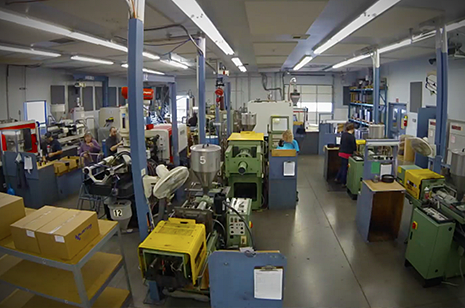- BY nwmcadmin
- POSTED IN Plastic Injection Molding, Plastic Injection Molds, Uncategorized
- WITH 0 COMMENTS
- PERMALINK
- STANDARD POST TYPE

When creating a product or part using injection molding, it’s easy to get caught up in that piece’s actual production. Things like material, size, and complexity are all important factors to consider and have a huge impact on production. But what about the look and feel of your product? If your product or part is going to be seen by customers, it’s time to start thinking about plastic finishes.
Choosing a surface finish is not just about appearance: it directly affects how a part will perform once it’s in the field. Certain finishes may improve scratch resistance, cleanability, or the part’s ability to hide fingerprints and light scuffs during daily use. Depending on the industry, a plastic surface finish type can even serve a functional purpose, like improving grip, enhancing chemical resistance, or making labeling/printing adhere more effectively to the part’s surface.
Plastic surface finishes can also influence cost. Higher-polish finish types take more time in the tool room because the mold must be polished to a higher degree before production starts. Lower-gloss finishes are often more cost-friendly because the polishing stage is less labor-intensive. So choosing the right finish is both a design and budget decision.

What are the plastic finish types?
Fabricators use plastic finishes to give the product its final look and to reduce the appearance of any blemishes or molding lines. These finishes are separated into grades classified by the Society of Plastics Industry, or SPI. The SPI states that plastic finishes are spread out across twelve separate grades, ranging from mirror shine to a dull matte. In general, these finishes can be placed in four broad groups.
Beyond helping the part look the way you expect, SPI plastic surface finish types can help engineers standardize expectations when moving from design to fabrication. When a designer calls out SPI A-2, for example, the tool room knows exactly how that surface must be polished — no subjective interpretation needed. That consistency becomes critical when multiple molds are involved.
Additionally, SPI finish types have become a language in industrial design. Certain industries — like consumer electronics, medical devices, and cosmetics — nearly always reference SPI grades on engineering drawings. So including the proper callouts for plastic surface finish types can speed RFQ cycles, reduce revision rounds, and help eliminate rework during prototyping.
Shiny Plastic Surface Finish Types
This group is made up of finishes A-1, A-2, and A-3. All are incredibly smooth and shiny, but A-1 is unique in that it is a mirrored finish. These finishes are all obtained using diamond powder suspended in an oil solution. Such incredibly reflective surfaces are often used to make plastic mirrors or other optical parts.
Shiny finishes are often selected for high-end consumer goods where a premium appearance is part of the value proposition. Think of phone bezels, cosmetic compacts, or luxury appliance controls — anything that must visually signal “polished” quality. These high-gloss finish types tend to show fingerprints more easily, so they are often paired with printed graphics or coatings to help maintain a clean look throughout use.
Polishing to these levels also requires the mold to be cut from high-quality tool steel with minimal inclusions. Poor steel quality can create micro-voids that prevent the mold from reaching a flawless gloss. That’s why shiny finishes tend to increase tooling cost and lead time, but the result is a surface that manufacturers simply cannot achieve through secondary finishing alone.
Semi-Gloss Plastic Surface Finish Types
Created using different types of grit paper, the semi-gloss finishes are smooth, but not to the degree of a shiny finish. Grades B-1, B-2, and B-3 range from medium to medium-low polish. These finishes can be used for the exterior of products as well as for parts that require a smoother finish.
Semi-gloss surface finish types strike a balance between premium aesthetics and practicality. They reflect light enough to create visual interest, but not so much that fingerprints and scuffs become distracting. Consumer goods like hand tools, personal care items, and automotive interior components often specify SPI B-series finishes. This is because they visually communicate quality without the added maintenance challenges of a mirror-like finish.
Semi-gloss finishes also perform well for products that need small areas of labeling or pad printing. The moderate smoothness allows ink to adhere consistently while still resisting wear. This makes B-series finishes useful in scenarios where readable icons, button labels, or safety instructions are molded directly into product housings.
Matte Plastic Finish Types
You primarily find matte and dull finishes in diecast and thermoset parts. They are created using a polish of fine stone powder. Matte finishes are categorized, predictably, from C-1 to C-3.
Matte finish types are popular in industries where the visibility of parting lines, sink marks, or weld lines must be reduced. Because they diffuse light rather than reflect it, the part appears more uniform, making it easier to achieve a consistent look even with complex geometries. Industrial equipment housings, power tool bodies, and rugged portable devices frequently use SPI C-grade finishes for this reason.
Matte finishes can also improve tactile feel. The very slight texture helps make the surface easier to grip, even if the user’s hands are wet or oily. This characteristic makes C-series finishes useful for medical equipment, lab instruments, and handling tools where ergonomic comfort matters as much as visual styling.
Dull Plastic Finishes
These surfaces are created using processes like sandblasting and can result in a finish ranging from satin to dull. These are the roughest and least polished grades and are often used for internal parts or for products that require such a finish.
Dull surface finish types are excellent at hiding molding imperfections and have fast cycles. For high-volume parts that customers never see, the speed and simplicity of a dull finish can significantly reduce tooling costs. These parts could be internal brackets, internal clip structures, or hidden frames. For rugged goods, dull finishes are also more forgiving in high-wear environments. The slight abrasions blend in rather than stand out.
Another advantage of dull finishes is that they can provide grip without the need for additional texture processing. Because the surface already has micro-texture from sandblasting, engineers can achieve the “tactile” effect they want without adding texture etching. This makes dull finish types not just an aesthetic choice but a functional one, especially for handheld equipment.

What plastic finish type should I use?
A good rule of thumb is to start with the end user experience. How should the part look and feel? Will it be customer-facing or hidden inside another assembly? Will it be handled daily, or largely untouched after installation? The answers to those questions help narrow down plastic surface finish types before tooling begins. This saves development time and protects your investment in the mold.
Because the industry widely recognizes the SPI system, calling out the correct grade early in the project can prevent costly iterations. Rex Plastics can help interpret your desired outcome — glossy, understated, premium, rugged — and match it to the proper SPI finish designation. That level of detail up front helps ensure your molded product looks exactly the way you intend.
As with many choices in the plastic injection molding process, the different elements used to create your product are best determined by the intended use of that product. That’s why it’s so important to have a trusted partner to work with; one that knows the industry inside and out. At Rex Plastics, we have decades of experience helping clients create exactly what they need. From massive production orders to unique prototypes, Rex Plastics is here to serve you for all your plastic needs. If you have a project you’d like to discuss, contact Rex Plastics with any questions or request a quote now.
Frequently Asked Questions
| Question | Answer |
|---|---|
Can different plastic finish types affect how well a colorant or dye looks in the final molded part? |
Yes. Highly polished finishes (A-series) tend to make color appear more saturated and glossy, while matte or dull finishes diffuse light, which can make color appear more muted. If brand color accuracy is critical — especially in consumer products — choosing the right finish type is just as important as selecting the resin and pigment. |
Are certain plastic surface finishes better for parts that will be UV exposed outdoors? |
Some finishes perform better over time in UV exposure because they do a better job hiding surface degradation. Matte or textured surfaces typically show less aging compared to highly polished glossy surfaces. That’s why outdoor products like consumer lawn equipment often use lower-gloss surface types; they maintain a consistent appearance as the material weathers. |
Do plastic finish types impact how well graphics, overmolds, or coatings stick? |
Yes. Adhesion is influenced by surface energy and texture. A slightly textured finish can sometimes improve bonding because coatings and secondary materials have more “micro surface area” to grip. In contrast, mirror finishes can sometimes require pretreatment to get proper adhesion. |
Are there finish types that help reduce squeaks or noise where two plastic parts rub together? |
Yes. Certain rougher finishes reduce contact surface area between parts, which can reduce squeaking/friction noise in assemblies. Engineers sometimes intentionally choose dull or matte finishes on sliding/latching plastic components for quieter operation without needing extra lubricants. |
Is it possible to change a finish type later without completely remaking the mold? |
It depends. Often you can go to a lower gloss (for example: from semi-gloss → matte) because that direction involves additional roughening or re-polishing. Going in the opposite direction (matte → high-gloss) is usually more difficult or may require steel welding and reworking. That’s why finish selection is best finalized during the early tooling stage. |
Referencing content from this page?
Please attribute either https://rexplastics.com/ or https://rexplastics.com/uncategorized/plastic-finish-types/
Suggested Citation:
Rex Plastics. (2021, January 07). Plastic Finish Types: What You Need to Know. https://rexplastics.com/uncategorized/plastic-finish-types/


